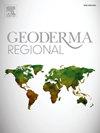苏丹-萨赫勒地区(喀麦隆远北)Maga地区土壤侵蚀敏感性评价:RUSLE模型与GIS耦合的贡献
IF 3.3
2区 农林科学
Q2 SOIL SCIENCE
引用次数: 0
摘要
水土流失是一项重大的环境、农艺和经济挑战,对非洲的粮食安全产生重大影响。这是一个影响农村世界社会经济发展的现实问题,因为在一个非常脆弱的生态系统中,土地大量流失,土壤贫瘠,保护不力,容易受到人为生态影响,并因气候变化和不平衡而放大。本研究的目的是评估Maga(喀麦隆远北)对水蚀的易感程度,并建立优先脆弱地区的模型,以便提出建议并可能采取行动。整合到地理信息系统(GIS)中的修订通用土壤流失方程(RUSLE)是评估水土流失易感性的最合适的方法方法,其中包括土壤学、地形学、气候和土地利用数据的贡献。多标准交叉参照建立侵蚀易感性图谱,根据风险等级,包括极高风险(6%)、高风险(18%)、中度风险(15%)、低风险(19%)和极低风险(36%)。曼达拉山脉(Mandara Mountains)平均降雨量高(900毫米/年)的大盆地(1400米)的形态直接影响了低至零坡度“Yaeres”的动态,径流过程改变了土壤(砂质和砂质粘土)的表面特性,由于有机质含量低(≤2%),经常出现水分亏缺,对侵蚀非常敏感。由于缺乏植物覆盖和不良的耕作方式,土壤颗粒分散且非常致密。此外,过度放牧、人口增长、砍伐树木、不受控制的森林大火和破旧的水利基础设施都导致了水土流失和沟壑的出现、生物多样性的丧失、生育率下降和农业产量下降。因此,侵蚀影响到土壤和水资源的可持续性,特别是水坝水库的寿命和非常脆弱的生态系统中含水层的补充,导致土地退化和荒漠化的加剧,随着时间的推移和在空间尺度上变得日益紧迫。它们对经济、环境和人口,特别是依赖这些资源的农村人口的福祉产生了影响。本文章由计算机程序翻译,如有差异,请以英文原文为准。
Assessement of soil erosion susceptibility in Maga, Sudano-Sahelian zone (Far North Cameroon): contribution of RUSLE model coupled with a GIS
Water erosion is a major environmental, agronomic and economic challenge that has a major impact on food security in Africa. It is a real problem that impacts the socio-economic development of rural world, through huge losses of land in a very fragile ecosystem whose soils are poor and poorly protected, exposed to anthropo-ecological effects, amplified by climate variability and imbalance. The aim of this study is to assess degree of susceptibility to water erosion in Maga (Far North Cameroon) and to Model out the priority vulnerable areas in order to make recommendations and possibly take action. The Revised Universal Soil Loss Equation (RUSLE) integrated into a Geographic Information System (GIS) is the most appropriate methodological approach for assessement susceptibility to erosion, with the contribution of pedological, topographical, climatic and land-use data. Multi-criteria cross-referencing establishes the erosion susceptibility map, according to the level of risk, including very high risk (6 %), high risk (18 %), moderate risk (15 %), low risk (19 %) and very low risk (36 %). The morphology of the large basin (1400 m) with high average rainfall in the Mandara Mountains (900 mm/year) immediately influences the dynamics of the low to zero slope “Yaeres” with a run-off process that modifies the surface properties of the soils (sandy and sandy-clay), with a frequent water deficit, due to their low organic matter content (≤2 %) are very sensitive to erosion. Soil particles are scattered and very compact, due to the absence of plant cover and poor farming practices. In addition, overgrazing, population growth, tree felling, uncontrolled bushfires and dilapidated water infrastructure all contribute to erosion and the emergence of gullies, loss of biodiversity, reduced fertility and lower agricultural yields. Erosion thus affects the sustainability of soil and water resources, in particular the longevity of dam reservoirs and the recharging of aquifers in a very fragile ecosystem, giving way to land degradation and the advance of desertification, which have become increasingly urgent over time and on a spatial scale. Their impact is felt on the economy, the environment and the well-being of populations, particularly rural populations who depend on these resources.
求助全文
通过发布文献求助,成功后即可免费获取论文全文。
去求助
来源期刊

Geoderma Regional
Agricultural and Biological Sciences-Soil Science
CiteScore
6.10
自引率
7.30%
发文量
122
审稿时长
76 days
期刊介绍:
Global issues require studies and solutions on national and regional levels. Geoderma Regional focuses on studies that increase understanding and advance our scientific knowledge of soils in all regions of the world. The journal embraces every aspect of soil science and welcomes reviews of regional progress.
 求助内容:
求助内容: 应助结果提醒方式:
应助结果提醒方式:


